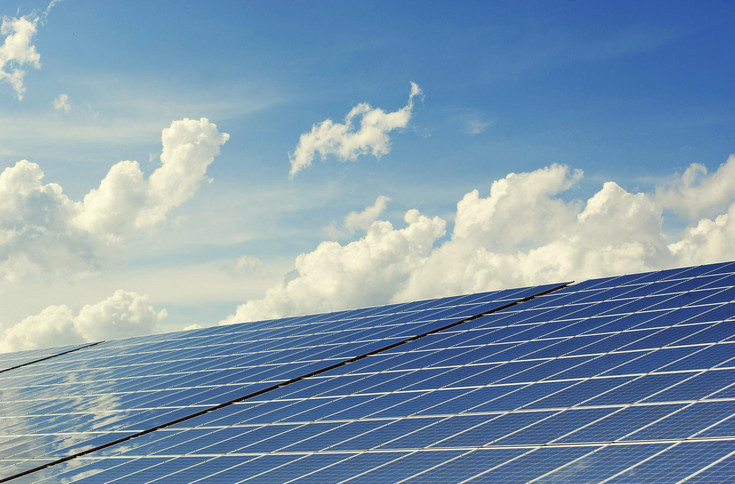18.05.2022 - New study calculates material requirements for a climate-compatible power plant fleet

Transforming and expanding the global electricity sector is central to mitigating climate change and alleviating energy poverty. In a new article, researchers from the Institute of Social Ecology at the University of Natural Resources and Applied Life Sciences, Vienna, analyse the material requirements and associated greenhouse gas emissions of different pathways in the electricity sector up to 2050.
Future electricity generation systems based on renewable energy sources can reduce greenhouse gas emissions, but need more raw materials during construction. In a new study, a team of researchers from the BOKU Institute of Social Ecology, led by Helmut Haberl, calculates the material requirements and associated greenhouse gas emissions of different pathways in the electricity sector up to 2050 as part of the EU project MatStocks.
How much raw material does the energy transition require?
The researchers assess the trade-off between climate protection and material requirements in the electricity sector by analysing what quantities of iron and steel, aluminium, copper and concrete are needed to expand the electricity infrastructure. Haberl's team determines the factors that are decisive for the material demand and evaluates the relevance of the energy transition in the electricity sector for the future demand for raw materials. This also plays an important role for future greenhouse gas emissions in the industrial sector, especially since the demand for the materials under consideration causes about one seventh of current global emissions. In order to take into account the variety of possible development paths, a total of 281 scenarios of the Integrated Assessment Modelling Consortium (IAMC) are evaluated, which also form the basis of current reports of the Intergovernmental Panel on Climate Change (IPCC).
Climate-friendly is more material-intensive
Five selected, very different scenarios are analysed in detail by calculating their respective annual material stocks and flows as well as the cumulative greenhouse gas emissions until 2050. According to this, the material demand in scenarios that are consistent with the 1.5 °C target is significantly higher than in scenarios that exceed a global temperature increase of 2 °C. This is because more material needs to be invested per amount of electricity generated for the expansion of photovoltaics, wind power and other renewable technologies than for fossil or nuclear energy. Material stocks in 2050 differ by up to 30% for copper, 100% for concrete, 150% for iron/steel and 260% for aluminium, even if the particularly material-intensive scenarios that limit global warming to below 1.5°C are excluded. Although power plants account for most of the material demand, grid expansion and reinforcement, which are necessary to accommodate a large share of volatile power generation and ensure universal access to electricity, also create significant material demand.
Material efficiency and low-carbon industrial processes crucial
Project leader Helmut Haberl: "The study shows that more material is needed to expand renewable power generation capacity, which also leads to greenhouse gas emissions. These investments pay off in the medium and long term because the need for fossil fuels is reduced. In addition, more efficient technology can limit the amount of material needed and reduce greenhouse gas emissions from the production of the materials needed." Without future GHG mitigation measures in manufacturing, GHG emissions related to bulk materials (mainly iron/steel and aluminium) could account for one-tenth of the remaining carbon budget, which offers a 50 per cent chance of limiting global warming to 1.5°C. However, if material-efficient technologies are favoured, low-carbon processes are applied in industries and increased material recycling is achieved, GHG emissions from increased expansion of renewable power generation technologies in decarbonisation pathways will not be significantly higher than those of scenarios in which largely fossil-fuel burning power plants are expanded.
In general, scenarios with a high share of renewables require more material than scenarios based on fossil fuels or nuclear energy, but the additional material demand is manageable compared to the material demand of the rest of the economy. There are also options to reduce the material intensity of renewable energy technologies and decarbonise the building materials sector, which could help to reduce material requirements and greenhouse gas emissions when installing additional renewable capacity.
"Measures to increase the energy efficiency of electricity-consuming plants at end consumers could also help to limit the material demand for additional power plants. If they were rolled out widely, renewable power plant technologies would have to be expanded less, or the replacement of fossil power plant capacities could be achieved more quickly," Haberl concludes.
Study
Gerald Kalt, Philipp Thunshirn, Fridolin Krausmann, Helmut Haberl 2022: Material requirements of global electricity sector pathways to 2050 and associated greenhouse gas emissions. Journal of Cleaner Production, Volume 358, 2022, 132014
doi.org/10.1016/j.jclepro.2022.132014
Contact:
Univ.Prof. Dr. Helmut Haberl
Institute for Social Ecology (SEC)
University of Natural Resources and Applied Life Sciences Vienna
helmut.haberl(at)boku.ac.at
Tel.: +43-699-19130591
